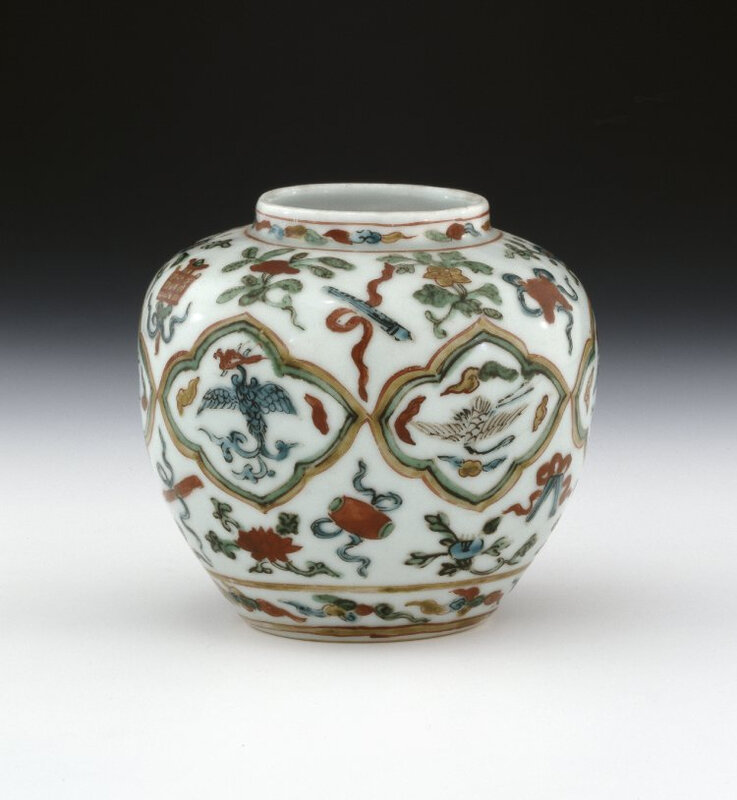Christie's. The Baofang Pavilion Collection of Imperial Ceramics, Hong Kong, 29 May 2019
A rare wucai ovoid jar, Jiajing six-character mark in underglaze-blue within a double circle and of the period (1522-1566)


Lot 2815. A rare wucai ovoid jar, Jiajing six-character mark in underglaze-blue within a double circle and of the period (1522-1566); 4 in. (10 cm.) high. Estimate HKD 400,000 - HKD 600,000. Price realised HKD 687,500. © Christie's Images Ltd 2019
The jar is decorated in overglaze turquoise, yellow, green, iron-red and black enamels with six quatrefoil cartouches, alternately enclosing phoenix or cranes, on a ground of twelve beribboned musical instruments interspersed with floral sprays, between bands of clouds around the rim and above the foot, box.
Provenance: Jingguantang Collection
Sold at Christie’s New York, 16 September 1998, lot 363.
Note: The decoration of this jar, especially the depiction of the twelve musical instruments, is very rare. The twelve instruments depicted on this jar in counterclockwise order are: qin, pan pipes, drum, two-ended gong, xiao, hand drum in the top row; sheng, flute, se, chime, castanets, waist drum in the lower row.
A jar of this form and decoration but with the twelve musical instruments arranged in a slightly different order is in the British Museum, illustrated in Jessica Harrison-Hall, Ming Ceramics, London, 2001, no.9:108, where the author explains that these instruments are traditional Chinese musical instruments whose origin may be traced to the Shang and Zhou dynasties, and that they represent the Bayin, ‘Eight Classes or Sounds’ of instrument – stone, metal, silk, bamboo, wood, skin, gourd and earth. The author makes a further remark on the importance of musical rites at the Ming imperial court.

Globular porcelain jar with overglaze red, green, yellow, turquoise and black enamels, Ming dynasty, Jiajing mark and period (1522-1566). Height: 10 cm. Bequeathed by Henry J Oppenheim, 1947,0712.266. © The Trustees of the British Museum.
This globular jar has a short neck and recessed base. Six octofoil cartouches, alternately framing phoenix or cranes, girdle the jar with twelve musical instruments and six pairs of different kinds of flowers painted above and below in a palette of overglaze red, green, yellow, turquoise and black enamels. Above the musical instruments are, anti-clockwise: 琴 'qin' [the zither], 'pai yue' [the pan pipes], 鼓 'gu' [the drum], 笛 'di' [the flute], 'luo' [the two-ended gong] and 'jigu' [a type of hand drum]. Below are six further instruments: anti-clockwise, these are 腰 鼓 'yaogu' [the waist drum], 笛 'di' [the flute], 琴 'qin' [the stone chime], 笙 'sheng' [a wind instrument comprising vertical tubes of different lengths], 琴 'qin' [the zither] and 拍 板 'pai ban' [the castanets]. A six-character underglaze blue Jiajing reign mark marks the base.
Harrison-Hall 2001:
These twelve musical instruments are traditional Chinese instruments whose origins may be traced to the Shang and Zhou dynasties. They represent the 'ba yin' [Eight Classes or Sounds] of instrument. These are stone, metal, silk, bamboo, wood, skin, gourd and earth. Typical Chinese melodies use a scale of five notes only (do, re, mi, so, la) and do not tend to repeat their melodies as Western tunes do. A wide range of musical instruments was used during the Ming period by scholars, professional musicians and entertainers. Scholars and members of the ruling elite cultivated their musical talents as one of the so-called Four Major Arts, the others being chess, calligraphy and painting. As well as a scholar's individual delight in his own or his friend's music, listening to professional musicians was a popular Ming pursuit. Numerous musicians were employed at court for entertainment and also to perform music for rites and ceremonies. In 1530 there were 2,200 musicians at the Spirit Music Temple, providing the Jiajing emperor with accompaniments for elaborate ceremonies. Both male and female musicians were employed at court. For example, a female orchestra, depicted as part of a palace scene by a group of anonymous workshop artists in the sixteenth century, is shown playing a wide range of musical instruments.

/https%3A%2F%2Fprofilepics.canalblog.com%2Fprofilepics%2F1%2F0%2F100183.jpg)
/https%3A%2F%2Fstorage.canalblog.com%2F03%2F02%2F119589%2F96711876_o.jpg)
/https%3A%2F%2Fstorage.canalblog.com%2F11%2F31%2F119589%2F94773502_o.jpg)
/https%3A%2F%2Fstorage.canalblog.com%2F20%2F83%2F119589%2F94772815_o.jpg)
/https%3A%2F%2Fstorage.canalblog.com%2F26%2F72%2F119589%2F75604929_o.jpg)
/https%3A%2F%2Fstorage.canalblog.com%2F59%2F60%2F119589%2F26458628_o.jpg)


/http%3A%2F%2Fstorage.canalblog.com%2F73%2F65%2F119589%2F126877960_o.jpg)
/http%3A%2F%2Fstorage.canalblog.com%2F34%2F60%2F119589%2F126529723_o.jpg)
/http%3A%2F%2Fstorage.canalblog.com%2F76%2F09%2F119589%2F122485126_o.jpg)
/http%3A%2F%2Fstorage.canalblog.com%2F80%2F25%2F119589%2F122457923.jpg)